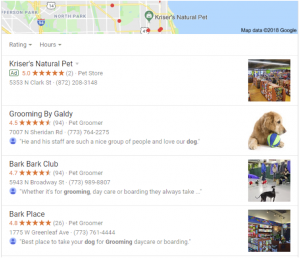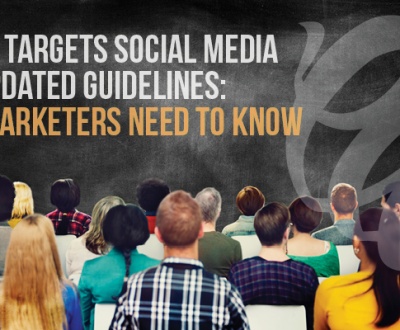Getting a local business to rank well in search results has never been more difficult.
This is due to two reasons:
- A massive increase in the number of mobile devices (meaning more people are turning to their phones to find businesses near them)
- An increasing number of businesses recognizing the benefits of local SEO.
There is also Google’s Local Pack, which pushes down the first website search result below the fold.
For the uninitiated, the Local Pack is the top section of the search results in Google that highlights three local businesses related to a search.
This section has been cut down from seven businesses and may also contain ads, as evidenced in this screenshot:

This is incredibly useful for mobile users.
They can quickly find a business near them and see hours, phone number, reviews, and more – all without ever clicking through to a website.
For businesses, it means local SEO has never been more critical.
To get found, you need more than good content.
You need local SEO and, ideally, you want to be included in Google’s Local Pack.
So, what are the best strategies to improve local SEO as a whole and increase your chances of being included in Google’s Local Pack?
As with most SEO questions, the answer isn’t cut and dry.
While I can’t give you the easy answer (hint: there isn’t one), I can outline many of the factors you should be looking at if you want to rank well as a local business.
What Are the Top Local SEO Ranking Signals?
Below, I have broken the most critical local SEO ranking signals into two sections:
- The Basics: This covers the most foundational ranking signals. If you want any chance at all of ranking well for local SEO, these are the factors you need to address.
- The Nitty Gritty Local SEO Ranking Signals: This details the more in-depth ranking signals. These are the signals to address if you are looking to move to the very top and knock a competitor out of the coveted Local Pack.
All signals included in the list are backed by statements from Google or by research. When possible, I have included links to those studies or statements.
Keep in mind, many of these signals deserve their own post, which isn’t possible here. In those cases, I have included additional reading suggestions so you can learn more.
The Basic Local SEO Ranking Signals
Want to make sure all your bases are covered on doing a full local SEO audit? Start here.
1. Google My Business
If you haven’t claimed your Google My Business page, do it now. It only takes a few minutes and is free.
Here is where to claim your Google My Business. This is one of the simplest and most effective ways to start improving your Local SEO.
2. Google My Business Categories
Within your Google My Business account, make sure you have chosen the correct categories.
For best results, use as few categories as possible and make sure they are as accurate as possible.
For example, don’t use “takeout restaurant” if you are a pizza restaurant where most customers dine in.
3. Photos on Google My Business Page
Take photos of your location, your products, your staff, even your customers (with permission, of course).
Photos help lend credibility to your business and serve as a local ranking signal.
4. Bing Places for Business
Google is the most talked-about search engine, but Bing still claims a decent market share (somewhere around 33 percent, depending on who you ask.)
Make sure you take the time to claim your Bing Places for Business account.
5. Online Directories/Citations
While we are online directories, make sure you have claimed other popular online directories, too. These include:
Citations don’t have as great of an impact on rankings as they once did, but are still important. (You don’t want to be the only local pizza joint that hasn’t claimed these listings!)
6. Listings on Review Sites
In addition to the online directories listed above, there are multiple review sites with listings you should claim. These include:
- Yelp.
- Glassdoor.
- Angie’s List.
- BBB.
It appears that reviews directly on Google carry the most weight.
7. Number of Positive Reviews
In addition to claiming your listing on review sites, you want to make sure the majority of your reviews are positive.
According to Google, high-quality reviews improve your business’ visibility.
Keep in mind that it is against Google’s review policies to ask for reviews in exchange for something or set up review stations. You can see all their review policies here.
Yelp and other review sites have similar policies.
8. Reviews with Keywords & Location
The language reviewers use matters, according to a Local SEO Guide study.
When reviewers use the city or keywords, it sends signals to Google that you are a trusted local business.
9. Reviews with Responses
The same Local SEO Guide study mentioned above showed that the number of reviews with a response also contributed to local SEO.
10. Percentage of Negative Reviews Not Responded To
In a double whammy, the number of reviews with responses counts, but so does negative reviews with no responses.
These last few signals make it clear you need to have a plan in place for following up to all online reviews, but particularly for Google.
11. Create a Facebook Business Page
Many people use Facebook as a search engine, which is why this has its own number on the list.
Make sure you at least create a business page and update it with your website, hours, and a description.
Social signals may have a limited impact, but they do have an impact on social SEO.
12. Social Listings
Claim other social listings on popular social sites (e.g., Twitter, LinkedIn, Instagram). Do this even if you don’t plan to be super active on those sites.
Pin a tweet or post inviting users to call/visit your website/follow you on whatever social platform you are most active on.
People expect a fast response from businesses on social, so be sure to leave a note or other contact info if you won’t be manning the channel.
13. Consistent NAP
Make sure your name, address, and phone number are consistent across all the listings above including review sites, maps, and social media.
Above all, Google wants to make sure they are providing accurate information.
Ensuring that your business name, address, and phone number are exactly the same makes it easy for customers to connect with your business when it shows up online.
Don’t, for example, have your business name as Rowe’s Famous Burger Joint in one place and Rowe’s Burger Joint LLC in another.
14. Mobile Responsiveness
Google’s mobile-first indexing has now rolled out. This means Google looks at your mobile site first, not your desktop site.
You should be on top of this already, but if you aren’t now is the time. Google’s mobile-friendly test can get you started.
The Nitty Gritty Local SEO Ranking Signals
If you have all the basics covered, it is time to look at some of the more in-depth local ranking signals.
Making adjustments in these areas will take you beyond the “good enough” stage of local SEO and give you a real shot at making the Local Pack.
Keep in mind, most of these are not quick fixes, they may even require a massive shift in strategy.
15. Structured Data Markup
There are several ways you can use structured data markups for local SEO, including for:
- Multiple departments.
- Hours.
- Address.
- Menu.
- Website.
- Phone number.
These are highly recommended by Google. You can add markups using Google’s guide or a tool like Schema.
It is also worth noting there is some lack of clarity on whether including GPS coordinates within structured data is helpful.
16. Click-Through Rates from Search Results
Turns out if you are doing well in SEO, you will do well in Local SEO. Go figure.
Focus on making sure your meta titles and descriptions make sense so users find what they expect when they arrive at your site.
17. Localized Content
Make sure you are consistently publishing content where you can organically including your key term and location.
For example, write about local events, share efforts to raise funds for a local charity, etc. Whatever makes sense for your brand.
18. On-page Location + Keyword Optimization
For example, don’t just optimize for “air conditioning repair”. Optimize for “air conditioning repair Chicago”.
19. Title + Meta Description
Use your key term and location in your title and meta descriptions when possible.
This one goes hand in hand with the signal above, but is important enough to be worth mentioning separately
20. High-Quality Inbound Links
No surprise here, links from sites Google trusts are good for SEO.
In fact, a solid link profile all around is good for local SEO.
21. Diversity of Inbound Links
Another no-brainer.
You want a range of inbound links that are relevant, are authoritative, and were gained organically.
These next few signals are ranked as the top local organic factors by Moz’s 2017 Local Search Ranking Factors survey.
22. Inbound Links from Local Relevant Sites
Links from local news sites, community blogs, and so forth prove that your site is trusted by your neighbors.
23. Inbound Using Local + Keyword in Anchor Text
A wide range of inbound links from well-optimized sites is great, but the holy grail is an inbound link from a high authority site using both your city or neighborhood and main key term.
24. Proximity to the Searcher
While you can’t optimize for physical location, it is a strong ranking signal, which is why claiming your Google my business and having consistent NAP is important.
25. Domain Authority of Your Website
According to Moz Local Search Ranking Factor, domain authority (not to be confused with the Moz metric of the same name) ranks sixth in the top 50 Local Pack Finder Factors.
Increasing your domain authority isn’t a quick or easy process, but it can pay off handsomely.
Conclusion
What do all these local SEO features mean for your local SEO strategies?
Here are two major takeaways:
- The single most important thing you can do to increase your local SEO ranking is to claim and optimize your Google My Business account. Several ranking signals are related to not just having a GMB listing, but optimizing it by choosing the correct categories, adding pictures, getting reviews, responding to reviews, and so forth.
- The second most important thing you can do for local SEO is to focus on a holistic SEO strategy for your website. Build a solid link profile, create useful content with both local and key terms, and make sure your meta descriptions are optimized.
Local SEO is a competitive field, but for most businesses, there are still plenty of areas where they can improve.
The list above will help you increase your local SEO ranking, increase your chances of being included in Google’s Local Pack, and, most importantly, help your customers find you.
About us and this blog
We are a digital marketing company with a focus on helping our customers achieve great results across several key areas.
Request a free quote
We offer professional SEO services that help websites increase their organic search score drastically in order to compete for the highest rankings even when it comes to highly competitive keywords.
Subscribe to our newsletter!
Recent Posts
- Top 25 Local Search Ranking Signals You Need to Know December 26, 2018
- Case Study: LeeHomeLoans.com August 19, 2017
- Case Study: H2O Offshore Adventures March 16, 2017






